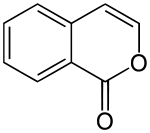Isocoumarin
Isocoumarin (1H-2-benzopyran-1-one; 3,4-benzo-2-pyrone) is a lactone, a type of natural organic compound.
 | |
| Names | |
|---|---|
| IUPAC name
1H-Isochromen-1-one | |
| Other names
Iso-coumarin; 1H-2-Benzopyran-1-one; 3,4-Benzo-2-pyrone | |
| Identifiers | |
3D model (JSmol) |
|
| ChEBI | |
| ChEMBL | |
| ChemSpider | |
PubChem CID |
|
| UNII | |
CompTox Dashboard (EPA) |
|
| |
| |
| Properties | |
| C9H6O2 | |
| Molar mass | 146.145 g·mol−1 |
Except where otherwise noted, data are given for materials in their standard state (at 25 °C [77 °F], 100 kPa). | |
| Infobox references | |
Known natural compounds
- Thunberginol A and B
- dihydroisocoumarins
- Hydrangenol
- Phyllodulcin
- Thunberginol C, D, E and G
- The derivative 3-acetyl-3,4-dihydro-5,6-dimethoxy-1H-2-benzopyran-1-one can be found in Huáng bǎi (Phellodendron chinense), one of the fifty fundamental herbs of traditional Chinese medicine.[1]
gollark: Well, the brain part is harder, but if you can work out the brain's I/O enough, that can just be simulated in detail and the rest to... really accurate computer game level.
gollark: I mean that just for a human-livable environment you don't need to actually simulate, say, particle interactions, at all.
gollark: You don't need to simulate things *exactly*, which helps.
gollark: So the universe's magic anti-paradox feature is forced to calculate it for you, or this generates some sort of really unlikely failure mode in your computing system.
gollark: 1. receive message from future containing the answer to your problem2. check it (this assumes it's one of the easy-to-check hard-to-answer ones)3. send it back
See also
References
- Cui, WS; Tian, J; Ma, ZJ; Guo, YQ; Wang, JH; Li, X (2003). "A new isocoumarin from bark of Pellodendron chinense". Natural Product Research. 17 (6): 427–9. doi:10.1080/14786410310001617695. PMID 14577693.
This article is issued from Wikipedia. The text is licensed under Creative Commons - Attribution - Sharealike. Additional terms may apply for the media files.